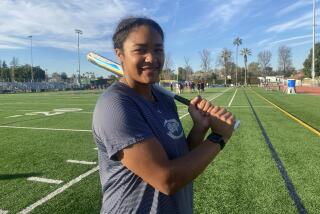CSUN Seeks to Rebuild After Losing Pair to Pros : College baseball: Kernen must fill void left by departures of Kloek and Richardson, who signed minor league contracts.
- Share via
Coach Bill Kernen experiments with the Cal State Northridge baseball lineup like a kid might tinker with the interchangeable parts of a Leggo set.
But last week, the lure of professional baseball pilfered two of Kernen’s most prominent building blocks.
The Milwaukee Brewers signed pitcher Kevin Kloek and second baseman Scott Richardson to minor league contracts. Both players had one remaining season of college eligibility.
Kloek, a fourth-round draft choice, had 111 strikeouts in 100 innings, an 8-2 record and a 3.15 earned-run average. Richardson, who was taken in the 15th round, led Northridge with a .342 batting average.
The loss of Kloek and Richardson, coupled with the departure of five seniors who were mainstays in the lineup, has led Kernen to conclude the Matadors are “starting over again.”
“It’s the beginning of the new phase,” said Kernen, who is 151-75-3 in four seasons at Northridge.
After only two seasons of Division I baseball, Northridge is an established playoff contender. The Matadors consistently have been ranked among the nation’s top 20 teams for the past season and a half.
“We got ourselves on the national baseball map,” Kernen said. “Our reputation is to the point that (recruits) look at us as a real option.”
Now comes the next step--presumably a berth in the College World Series.
Kernen just hopes the next stride isn’t backward.
Already operating on a shoestring and about $20,000 shy of the NCAA scholarship maximum, the Northridge baseball program faces cutbacks at a time when an extra monetary boost might push the Matadors to the top.
Without additional financial assistance from the school, Kernen cites a greater need for contributions from baseball boosters in the community.
However, he is squarely enveloped in a Catch-22.
He knows public support will not develop further unless the school offers more on its end.
The conditions at Matador Field are a prime example. The playing surface is below par of competing Division I schools. So, too, are the lavatories and concession areas.
“People can’t even go to the bathroom comfortably,” Kernen said. The only restrooms at the field are three temporary cubicles stationed behind the bleachers.
Kernen cites national champion Pepperdine as a school that has spent its money for athletics wisely.
“Whatever investment they made was brought back a hundred times by the publicity they got on ESPN and in the newspapers during the (College World) Series,” Kernen said. “They couldn’t have bought that kind of exposure, not with a million dollars.”
Later this month, Kernen will meet with Athletic Director Bob Hiegert to discuss the school’s commitment to its baseball program.
Meanwhile, the problems Kernen faces are not only financial. Northridge, minus its top three pitchers from this year’s team, enters the Western Athletic Conference for baseball next season, joining Fresno State, Hawaii, San Diego State and Cal State Sacramento in one of the toughest divisions in the nation.
But while the draft took away two key players, it left catcher Mike Sims and pitchers Kevin Kempton and Steven Morales, players whose collective departure might have been devastating.
Sims, a three-year starter who will be a senior, has batted in the .300 range the past two seasons and is a defensive stalwart. Kempton, a right-hander from East Los Angeles College, was Kernen’s top junior college pitching recruit.
Morales, who will be a senior, was 4-1 with a 2.43 ERA when he was forced out with a stress fracture near the back of his right elbow. Before his injury, Morales was considered an early- to middle-round draft prospect. In 63 innings, Morales struck out 66 and allowed only 43 hits.
“He is going to be one of, if not the, best starting pitcher in California college baseball,” Kernen said of Morales. “I think that’s right where he was this year.”
John Bushart (5-2, 4.23 ERA), a senior left-hander, is expected to step into a more prominent role, as are sophomores Jason Van Heerde and Jason Shanahan.
Van Heerde, a high school catcher, pitched 3 2/3 innings in four appearances, allowing only one run. Shanahan didn’t pitch in a game during his freshman campaign, but he saw plenty of action in intrasquad competition, a technique Kernen employed to develop Craig Clayton in 1989.
The following season, Clayton helped pitch the Matadors to the Division II championship game. The next season, he was 14-5 and was a first-team Division I All-American.
Like Clayton, Shanahan hits as well as he pitches. “And he’s a pretty good pitcher too,” Kernen said. “His stuff isn’t unbelievable but he competes.”
Kernen used to describe Clayton in similar terms. In fact, Kernen has predicted the Matadors would have played in the College World Series this spring had either Clayton or Scott Sharts not signed professional contracts after their junior seasons a year ago.
Now Kloek and Richardson have done the same.
“Our team would look a little different right now with those guys in there, but that’s baseball,” Kernen said. “That’s the way it’s going to be. It’s just another indication of where we are. If you’re good in Division I baseball, you’re going to lose some guys.”
More to Read
Go beyond the scoreboard
Get the latest on L.A.'s teams in the daily Sports Report newsletter.
You may occasionally receive promotional content from the Los Angeles Times.











